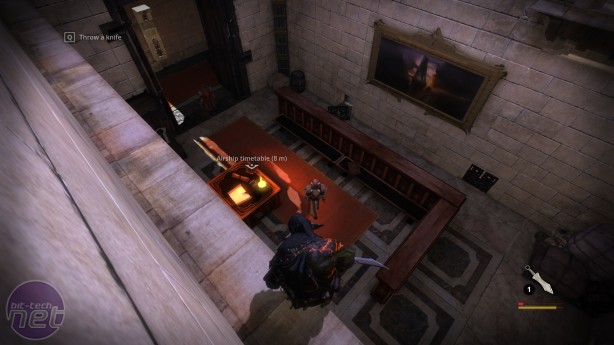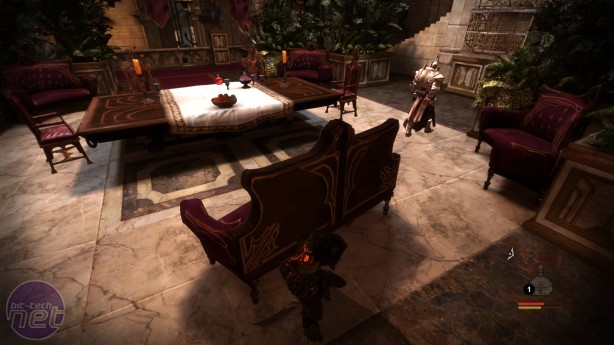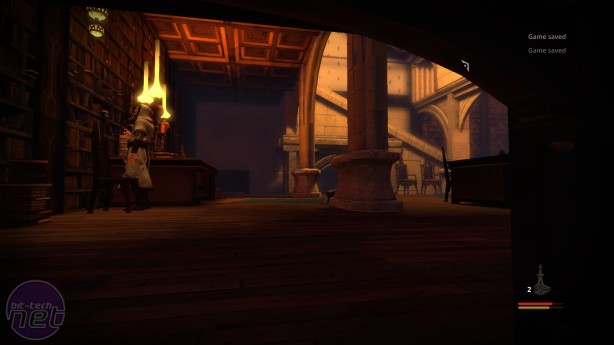Styx: Master of Shadows Review
October 31, 2014 | 10:15
Companies: #cyanide-studios #focus-home-interactive

Such alternative routes aren’t always available, however, and there are plenty of times when Styx must rely on his own skills to evade rather than avoid detection. The most novel of these is the ability to clone himself, creating a less powerful but equally agile version of himself, which can then be directly controlled by the player. Clones are useful mainly for creating distractions, pulling guards away from their usual patrols and giving Styx the opportunity to slip quietly past. But clones can also be used to set traps in cupboards and storage boxes, hold down guards while Styx quietly dispatches them, and, strangely, crawl through gaps that Styx cannot, which doesn’t make a huge amount of sense given they’re supposedly clones.
Alongside this relatively unique power are a range of more familiar sneaky abilities including stealth takedowns, equipment such as throwing knives and balls of sand to put out torches at a distance, and the power to very briefly turn invisible. Styx can also upgrade his skills between missions, widening his range of takedowns, decreasing the noise he makes when he jumps or runs, increasing the capabilities of his clones and so forth.
The number of tactical options Styx gives you to tailor your approach is genuinely impressive, and almost every ability comes in handy at one point or another. Unfortunately, although Styx excels in terms of giving the player options and variety, its stealth systems leave a lot to be desired. The biggest problem is inconsistency. A good example is “hanging” from ledges. When grabbing some ledges Styx will automatically dangle from them, whereas with others he will automatically clamber onto the ledge. Many times I’ve witnessed Styx pull himself up right in front of a guard, which always ends badly since Styx is next to useless in open combat.
Moreover, the controls lack precision. Styx will happily waltz into the abyss if you’re not careful, which given Master of Shadows involves navigating a lot of narrow ledges, quickly becomes frustrating. I also found it difficult to judge to what extent I was hidden from the view of patrolling watchmen. Ironically, shadows are probably the least useful way to conceal Styx’s presence. The Amber beneath Styx’s skin glows to signify when he’s hidden in shadow, but being in shade only seems to slightly decrease your visibility. It’s always surer to hide beneath a table or simply get above them. Hence why I feel “Master of Shadows” to be such a misnomer.
The loosey-goosey systems and controls are frustrating, but they aren’t a deal-breaker. By the halfway point I was pretty comfortable inhabiting Styx. Unfortunately, the halfway point is also where the game stops trying. There are six missions in Styx, each of which is split into three or four large open levels. Most of these have a secondary objective to accomplish which rewards you with additional skill points, making it worth the explorative detour. As of missions three, however, Styx begins to re-use previously explored environments. It isn’t a complete rehash, but it’s clear at this point the developers looked in the treasury and found only cobwebs and dust.
One last point that I want to mention. The writing is abysmal, sometimes hilariously so. It attempts the cynical wit of Thief, right down to the animated, narrated cutscenes. Yet ponderous dialogue exchanges and awkward jokes about male genitalia ruin the tone. It could partly be due to a translation issue, but lines such as “When I step into the lion’s den, it’s to f**k a lion!” make me think otherwise. Styx: Master of Shadows, Destroyer of Metaphors.
Despite these issues, you could do worse for a stealth game than Master of Shadows. The variety it offers both in level design and tactical approach outweigh its systemic inconsistencies and repetition in the second half. I wouldn’t call Styx a Master of Shadows, but he’s definitely a journeyman, and he’s on his way up.
Alongside this relatively unique power are a range of more familiar sneaky abilities including stealth takedowns, equipment such as throwing knives and balls of sand to put out torches at a distance, and the power to very briefly turn invisible. Styx can also upgrade his skills between missions, widening his range of takedowns, decreasing the noise he makes when he jumps or runs, increasing the capabilities of his clones and so forth.
The number of tactical options Styx gives you to tailor your approach is genuinely impressive, and almost every ability comes in handy at one point or another. Unfortunately, although Styx excels in terms of giving the player options and variety, its stealth systems leave a lot to be desired. The biggest problem is inconsistency. A good example is “hanging” from ledges. When grabbing some ledges Styx will automatically dangle from them, whereas with others he will automatically clamber onto the ledge. Many times I’ve witnessed Styx pull himself up right in front of a guard, which always ends badly since Styx is next to useless in open combat.
Moreover, the controls lack precision. Styx will happily waltz into the abyss if you’re not careful, which given Master of Shadows involves navigating a lot of narrow ledges, quickly becomes frustrating. I also found it difficult to judge to what extent I was hidden from the view of patrolling watchmen. Ironically, shadows are probably the least useful way to conceal Styx’s presence. The Amber beneath Styx’s skin glows to signify when he’s hidden in shadow, but being in shade only seems to slightly decrease your visibility. It’s always surer to hide beneath a table or simply get above them. Hence why I feel “Master of Shadows” to be such a misnomer.
The loosey-goosey systems and controls are frustrating, but they aren’t a deal-breaker. By the halfway point I was pretty comfortable inhabiting Styx. Unfortunately, the halfway point is also where the game stops trying. There are six missions in Styx, each of which is split into three or four large open levels. Most of these have a secondary objective to accomplish which rewards you with additional skill points, making it worth the explorative detour. As of missions three, however, Styx begins to re-use previously explored environments. It isn’t a complete rehash, but it’s clear at this point the developers looked in the treasury and found only cobwebs and dust.
One last point that I want to mention. The writing is abysmal, sometimes hilariously so. It attempts the cynical wit of Thief, right down to the animated, narrated cutscenes. Yet ponderous dialogue exchanges and awkward jokes about male genitalia ruin the tone. It could partly be due to a translation issue, but lines such as “When I step into the lion’s den, it’s to f**k a lion!” make me think otherwise. Styx: Master of Shadows, Destroyer of Metaphors.
Despite these issues, you could do worse for a stealth game than Master of Shadows. The variety it offers both in level design and tactical approach outweigh its systemic inconsistencies and repetition in the second half. I wouldn’t call Styx a Master of Shadows, but he’s definitely a journeyman, and he’s on his way up.

MSI MPG Velox 100R Chassis Review
October 14 2021 | 15:04













Want to comment? Please log in.